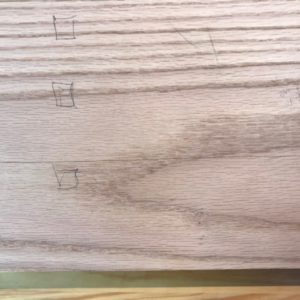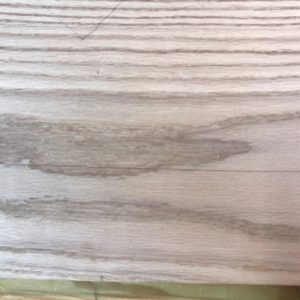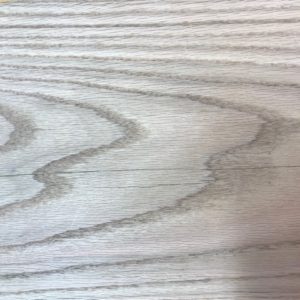First, yes, clearly my error.
I’ve managed to split a 10 inch wide red oak cabinet side while taking apart the dry fit for a cabinet. The side is 7/8 inches thick and roughly 40 inches long. The split runs the full length of the case side.
I’ve attached 3 pictures. The split seems to be 1/64th wide +/-. While it does go clear through, it’s not close to being a full break. There’s just a bit of flex if I lightly raise one side of the case.
Can this be fixed? I’m not sure if I can fill the crack with epoxy (it’s not very wide). When I get to final assembly, if need be, I can pin a couple of temporary cross pieces to the back side of the board until I get the joints on each end seated.
Ripping the split out and gluing the side back together isn’t an option as far as I can tell. I’d have to remill a bunch of stock and would likely end up having to “remake’ the case sides / top and bottoms again anyway.
Yes, I do care about final appearance, however, this is for Peckovich’s hanging tool cabinet (it’ll be in my shop, not in the house,) and the damaged face will not be easily visible based on where I expect to hang the cabinet. So, yes, I’ll always know it’s there and it’ll bug me forever… but I think I can live with it. If it was a piece of “in-the-home” furniture, I’d not bother to try to fix it but mill a new side.
My options, as I see it are to a) mill a new case side (including cutting the tails which is what I really hope to avoid, other than the loss of lumber,) b) find some way of getting glue into the crack as best I can along the full length and see what happens, or c) tack the temporary cross bracing in place on the back and hope for the best.
Any and all thoughts (or tongue lashings for getting mallet happy during the disassembly) welcome. Experience is the best teacher.
Thank you.


















Replies
I've never tried it, but have seen a video on YouTube where someone put glue along the crack on one side of the board and then used a shop vac from the other side to suck the glue into the crack. Looked pretty slick on the video.
Another option is to put several bow tie keys along the crack to hold it together. These would be permanent and visible, unless you hid them on the inside, but if I were going to go to the trouble I would want them to be seen.
Third option is to douse the crack with a thin CA glue. It will definitely seep into the crack and stick. it might take more than one application to strengthen it up.
I'll just mention that I've always found it hard to repair a long thin crank with epoxy without creating a mess. Getting a clean fix on both sides, that you can finish over is the hard part. It seeps, and epoxy wont absorb stain so you can get a narrow line of light color. It doesn't seem to be a structural strength issue. I'd try a patch from the backside, myself, but your concern about aesthetics exceeds mine.
I just took a feeler gauge to the split. .010” at its widest on either surface. Thanks for the above 2 suggestions. I’m all ears!
You could disassemble, and work some glue into the crack, as much as you can. Use liquid hide glue, for sure. Then clamp it up.
If it is really coming apart, let it. It's a perfect split. Then glue with hide glue and clamp. No need to rip.
I wouldn't bother with butterflies, braces, or anything else. The case is dovetailed, so there is plenty to hold it together, even with a partial split.
To clarify, hide glue will not interfere with stain or finish the way that epoxy or yellow glue will.
You could also build up a little tape "dam" and put glue on, them blow it into the crack with compressed air or even just a soda straw. Flex it slightly to do both sides and then clamp it up. I'd go with the liquid hide glue.
If the cracks are extensive, it would be safest to carefully extend them so the parts can be separated then properly reglued & clamped together again, with hide glue likely to be the least visible, as John_C2 says.
But ...... have you fixed the underlying cause of the cracking? This isn't so much the (un)happy malleting (the proximate cause) but more likely a poor fit of the dovetails. You had to mallet-whack them hard to fit and unfit them. A slightly too-thick pin or two, jammed into the corresponding tail slots, has probably caused the sideways pressure that has begun then extended the splits.
Been there. Done that. :-)
So, don't fall into the trap of fixing the cracks only to re-introduce them by not refining the fit of those pins and tails. It's probably a matter of only the teeniest shaving off a pin side or two until you can fit the tails and pins together with a very firm hand push rather than having to mallet them together.
Lataxe
Thank you all! Great advice as usual. Hadn’t thought of hide glue. And I’ll go back over my pins again.
Hope all have a super weekend.
To me, it begs for thin CA glue and a little clamping pressure.
It may still be visible, but acceptable.
I would do it after the case is glued up.
I would use thinned wood glue, or thin CA, or some form of thin epoxy, along with some good clamps to get it glued back together. Then, I would use a router and an inlay kit and put some butterfly inlays, on the outside to show off, or hide them on the inside just for the nice solid reinforcement. (I'd use full strength glue on the inlays)
I have that tool cabinet hanging in my shop and love it, so I fully understand that dovetails on 7/8" stock are a bit more difficult than with 3/4."
I have had several successes using cyanoacrylate glue to repair splits. Last time I used some of the thin consistency intended for finishing pen turnings. Its thin enough to easily enter the crack all the way. I used it ion walnut a couple of times. In both cases, I used a card scraper to eliminate whatever got on the surface. Both repairs are holding nicely.
Thank you all!! I forced as much hide glue into the crack as it would take. It seemed like it’ll hold through glue up. I’ve worked down what I think are the offending pins. If it holds thru glue up, we’ll I think it’ll be fine. If not, and it re-splits I’ll try CA. If all else fails, well I’ll mill a new case side.
Good to hear it's solved.
I have a similar problem, although far more challenging, than yours. I'm on the Board of
Trustees of historic site, and do many repairs on the furnishings. There is a Queen Anne highboy made in 1790, valued at $78,000. A rear leg has split due to the women dragging it around, and it needs to be fixed, and guess who they asked. It is property of the State and I won't touch it without a written OK from them. One side has a very old split that was repaired by screwing a batten.
Im thinking of warming the leg slowly with a heat lamp, then flexing it just enough to open the split a few thousandths, then injecting warm hide glue with a hypodermic. Ive been putti g this off for 2 years. Any thoughts - other than run ?
Run sounds like a plan. I’m certainly not knowledgeable enough to help. I’ve not heard of thinning glue to the point it would pass through a needle but I suppose it’s possible. I’m looking forward to the responses tho. As is all life... SOMEONE. Is always facing a steeper climb. Great bunch of folks on here imo. I’ll bet someone will have something helpful. Best wishes!
This forum post is now archived. Commenting has been disabled